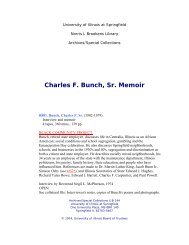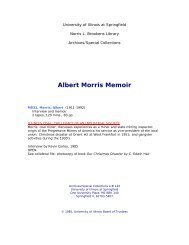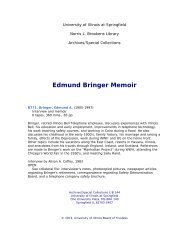Gerald W. Smith Memoir - Brookens Library
Gerald W. Smith Memoir - Brookens Library
Gerald W. Smith Memoir - Brookens Library
You also want an ePaper? Increase the reach of your titles
YUMPU automatically turns print PDFs into web optimized ePapers that Google loves.
<strong>Gerald</strong> W. <strong>Smith</strong> 2141:districts in Illinois and we had gone through a very difficult battl IIn reducing that nuher. The feeling was that on the basis of a 30, 00population we might end up in establishing fw too many districts.was the real base. They didn't want Illinois to repeat what was seea rdstake in the past, by forming far too many school districts on tsmall a population and tax base. It was a concern. Another one re1 edto this matter of size, the Master Plan had recornmended that the districtsbe able to give evidence that within five years of their establishntthey could produce a fill-time enrollrent of 1,000 students downstate and2,000 in the Chicago Metropolitan area. Again, the Southern Illinoispeople, looking at their sparse population, felt that the standard wastoo high. And so, these are really the same objections but they werephrased in two different ways. This was one of the issues--the standardfor the formation of a district in regard to population base, in regardto assessed valuation, with regwd to pmjected enrollment.Another concern that developed was in response to the proposal, that residentsof Illinois be authorized to attend publfc junior college districtsand have a part of their cost paid by local areas rewdless of whether theylived in a dfstrict or not. Now the basic proposal to make this possiblewas supported. The opposition that developed was with regard to the planproposed for the payment of that support from the non-junior college areasor territories. The proposal, as listed in the Master Plan, was that inany school district lying outside a junior college district, funding shouldbe provided by having the county superintendent of schools withold stateapportiomnt payments to that local school district for the purpose ofpaying the junior college tuition, or that shme of it which was to be alocal share. There were nwnberous objectors to that, and one of the mostvocal of those objectors was me. At that time I was semring as the ExecutiveDirecto~ for the Association of School Administrators and in thatrole I objected to it on the basis that we were going to pull money awayfrom elementary/secondauy school districts for the purpose of juniorcolleges, and I did not think that that was a good idea. objectimswere, as I espoused at that time, were as follows:1. I thought it was both administ~atively and morally wrong to allowan administrative officer sanewhere in the State to drain off f'undsthat had been earmarked by the General Assembly for a specific purposeand redirect them to some other place. I felt very stronglyabout that point.2. 1 felt that, and I was able to document, In fact, that the aountof money available fkom that source Sn some codties woal& ndt besufficient to pay the tuition. In other words, a township or a corninunityhigh school district which at that time received a very modestmmt of state aid, might find that its total state aid had beendiverted to a junior college and the junior college would find thatthat total state aid that was coming to them wasn't enough money topay their cLaipl. So this was an inadequate source in a limitedslumber df caseqnot too many. I was able, for example, to documentthat Hall Township High School, which had a sizable number of peioplegoing to the LaSalle-Peru4glesby junior college, would not proenough money through that sowce to meet the claims thatto them.





